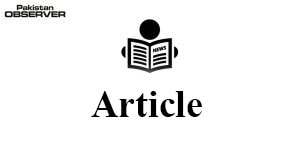Mysterious world of monetary policy and public debt
THE Prime Minister and members of his cabinet have repeatedly said that the debt taken by previous governments is the root cause of economic woes in Pakistan.
The Prime Minister and his team argue that it is the debt which engulfs entire budget and leaves nothing for the other purposes.
At this point, it sounds very strange if I claim that the debt stock is totally irrelevant for the budget allocation.
But it is in fact true that the total stock of public debt is actually irrelevant in the budgeting for federal government.
If you look at the latest budget details for the federal government, you will find there is no single rupee allocated for the debt repayment.
What is there in the budget is ‘Mark-up Payments on Domestic Debt’ and this is the single largest allocation in the federal budget. This means, we don’t repay the debt, we are paying only the mark-up on the debt borrowed by the present and previous governments.
In the fiscal year 2020-21, PKR 2631 billion were reserved for the mark-up payments which make 41% of the total budget outlay.
This allocation is more than double of the defence spending and more than five multiples of the allocation for running of entire civil government.
Therefore, the problem is not the debt stock per se, but the problem is amount of mark-up on it.
The second surprise is that the mark-up payments are the choice of government. If the government wants, she can reduce the mark-up payments to 500 billion, saving PKR 2100 billion for other functions of crucial importance such as Diamer-Bhasha Dam.
The mark-up payments are associated with the policy rate, the benchmark interest rate that State Bank of Pakistan decides.
If the SBP chooses policy rate to be low, the mark-up payments will also reduce and vice versa.
After taking charge, the PTI government increased the policy rate from 6% to 13.25%, therefore, increased the mark-up payment by very large amount. Later on, the policy rate was reduced to 7% due to pandemic.
A large part of government debt is in the form of short term debt with maturity period of three months.
The mark-up on this short term debt is very closely associated with the policy rate. Today, the short term debt of Pakistan is about PKR 5000 billion and the policy rate is 7%.
At this policy rate the mark-up payments would be close to 350 billion. For the same amount of short term debt that we have, if the government chooses a policy rate of 2%, the mark-up payments would reduce to 100 billion and if the government chooses a policy rate of 12%, the mark-up payments would rise to 600 billion.
The mark-up payments on long term debt are also associated with policy rate through a relatively complicated mechanism.
The government has intentionally and voluntarily agreed to such a high policy rate and resultant mark-up payments.
The third surprise is, the debt is problematic only for Pakistan. Many nations have borrowed extensively from their banks, but that debt is not problematic for them. This is because of choice of policy rate.
Pakistan has one of highest policy rates in the world; therefore, Pakistan has to make large mark-up payments on public debt. The borrowing in most parts of the world is not that much expensive.
The policy rate in the United States today is only 0.25%, which means if the US borrows 1000 billion, they need to pay 2.5 billion per year as mark-up.
On the other hand, if Pakistan borrows, we would need to pay 70 billion because of our choice of policy rate.
The current policy rate which is 0.5% in Thailand, 3% in India and 0.1% in Israel. If we opt the policy rate of Thailand, the mark-up payment on the public debt of 24000 billion will reduce to 120 billion, creating a fiscal space of about 2500 billion. The fourth surprise is the policy rate is kept high to keep inflation low.
If you read the monetary policy statements for the last three years, you will find main focus of the SBP in deciding policy rate is inflation.
Therefore, the 2631 billion that we pay as mark-up payment is actually the cost of inflation control.
The nation is paying this fee to control inflation in the country. The deficit in government budget is not because of the borrowing but because of payment of this inflation control fee.
The fifth surprise is; the State Bank of Pakistan is constitutionally mandated to do the research on state of economy. The SBP documents everything about the economy of Pakistan, but doesn’t have any evaluation of its own monetary policy which engulfs PKR 2631 billion every year.
There is no single document available on the website of SBP which provides a proof of functionality of the monetary policy and/or provides evidence that the monetary policy was actually helpful in controlling inflation.
The sixth surprise is, most of the economists are unaware of the borrowing mechanism and its consequences.
The monetary policy courses taught in most of the academic programs revolve around the practices abandoned fifty years ago and have no mention of the Inflation Targeting Framework that is currently being followed by central banks.
A very small group of economists understands the mechanism of borrowing and this group is also silent on the consequences of monetary policy.
The list of wonders didn’t end here; there are many other mysteries in the world of monetary policy. Wait for the second episode to know more about these mysteries.
—The writer is Director, Kashmir Institute of Economics, University of Azad Jammu and Kashmir.










